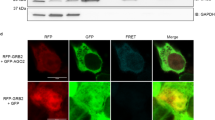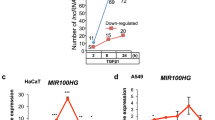Abstract
MicroRNAs (miRNAs) have emerged as key post-transcriptional regulators of gene expression, involved in diverse physiological and pathological processes. Although miRNAs can function as both tumour suppressors and oncogenes in tumour development1, a widespread downregulation of miRNAs is commonly observed in human cancers and promotes cellular transformation and tumorigenesis2,3,4. This indicates an inherent significance of small RNAs in tumour suppression. However, the connection between tumour suppressor networks and miRNA biogenesis machineries has not been investigated in depth. Here we show that a central tumour suppressor, p53, enhances the post-transcriptional maturation of several miRNAs with growth-suppressive function, including miR-16-1, miR-143 and miR-145, in response to DNA damage. In HCT116 cells and human diploid fibroblasts, p53 interacts with the Drosha processing complex through the association with DEAD-box RNA helicase p68 (also known as DDX5) and facilitates the processing of primary miRNAs to precursor miRNAs. We also found that transcriptionally inactive p53 mutants interfere with a functional assembly between Drosha complex and p68, leading to attenuation of miRNA processing activity. These findings suggest that transcription-independent modulation of miRNA biogenesis is intrinsically embedded in a tumour suppressive program governed by p53. Our study reveals a previously unrecognized function of p53 in miRNA processing, which may underlie key aspects of cancer biology.
This is a preview of subscription content, access via your institution
Access options
Subscribe to this journal
Receive 51 print issues and online access
$199.00 per year
only $3.90 per issue
Buy this article
- Purchase on Springer Link
- Instant access to full article PDF
Prices may be subject to local taxes which are calculated during checkout




Similar content being viewed by others
References
Esquela-Kerscher, A. & Slack, F. J. Oncomirs—microRNAs with a role in cancer. Nature Rev. Cancer 6, 259–269 (2006)
Lu, J. et al. MicroRNA expression profiles classify human cancers. Nature 435, 834–838 (2005)
Kumar, M. S., Lu, J., Mercer, K. L., Golub, T. R. & Jacks, T. Impaired microRNA processing enhances cellular transformation and tumorigenesis. Nature Genet. 39, 673–677 (2007)
Chang, T. C. et al. Widespread microRNA repression by Myc contributes to tumorigenesis. Nature Genet. 40, 43–50 (2008)
Kim, V. N. MicroRNA biogenesis: coordinated cropping and dicing. Nature Rev. Mol. Cell Biol. 6, 376–385 (2005)
Gregory, R. I. et al. The Microprocessor complex mediates the genesis of microRNAs. Nature 432, 235–240 (2004)
Fukuda, T. et al. DEAD-box RNA helicase subunits of the Drosha complex are required for processing of rRNA and a subset of microRNAs. Nature Cell Biol. 9, 604–611 (2007)
Ozen, M., Creighton, C. J., Ozdemir, M. & Ittmann, M. Widespread deregulation of microRNA expression in human prostate cancer. Oncogene 27, 1788–1793 (2008)
Zhang, L. et al. Genomic and epigenetic alterations deregulate microRNA expression in human epithelial ovarian cancer. Proc. Natl Acad. Sci. USA 105, 7004–7009 (2008)
Marton, S. et al. Small RNAs analysis in CLL reveals a deregulation of miRNA expression and novel miRNA candidates of putative relevance in CLL pathogenesis. Leukemia 22, 330–338 (2008)
Calin, G. A. et al. Human microRNA genes are frequently located at fragile sites and genomic regions involved in cancers. Proc. Natl Acad. Sci. USA 101, 2999–3004 (2004)
Thomson, J. M. et al. Extensive post-transcriptional regulation of microRNAs and its implications for cancer. Genes Dev. 20, 2202–2207 (2006)
Michael, M. Z., O’ Connor, S. M., van Holst Pellekaan, N. G., Young, G. P. & James, R. J. Reduced accumulation of specific microRNAs in colorectal neoplasia. Mol. Cancer Res. 1, 882–891 (2003)
Karube, Y. et al. Reduced expression of Dicer associated with poor prognosis in lung cancer patients. Cancer Sci. 96, 111–115 (2005)
He, L. et al. A microRNA component of the p53 tumour suppressor network. Nature 447, 1130–1134 (2007)
Chang, T. C. et al. Transactivation of miR-34a by p53 broadly influences gene expression and promotes apoptosis. Mol. Cell 26, 745–752 (2007)
Tarasov, V. et al. Differential regulation of microRNAs by p53 revealed by massively parallel sequencing: miR-34a is a p53 target that induces apoptosis and G1-arrest. Cell Cycle 6, 1586–1593 (2007)
Bates, G. J. et al. The DEAD box protein p68: a novel transcriptional coactivator of the p53 tumour suppressor. EMBO J. 24, 543–553 (2005)
Bueno, M. J. et al. Genetic and epigenetic silencing of microRNA-203 enhances ABL1 and BCR-ABL1 oncogene expression. Cancer Cell 13, 496–506 (2008)
Kondo, N., Toyama, T., Sugiura, H., Fujii, Y. & Yamashita, H. miR-206 expression is down-regulated in estrogen receptor α-positive human breast cancer. Cancer Res. 68, 5004–5008 (2008)
Tsutsui, M. et al. Establishment of cells to monitor Microprocessor through fusion genes of microRNA and GFP. Biochem. Biophys. Res. Commun. 372, 856–861 (2008)
Soussi, T. & Beroud, C. Assessing TP53 status in human tumours to evaluate clinical outcome. Nature Rev. Cancer 1, 233–240 (2001)
Soussi, T. p53 alterations in human cancer: more questions than answers. Oncogene 26, 2145–2156 (2007)
Song, H. & Xu, Y. Gain of function of p53 cancer mutants in disrupting critical DNA damage response pathways. Cell Cycle 6, 1570–1573 (2007)
Adorno, M. et al. A mutant-p53/Smad complex opposes p63 to empower TGFβ-induced metastasis. Cell 137, 87–98 (2009)
Sandberg, R., Neilson, J. R., Sarma, A., Sharp, P. A. & Burge, C. B. Proliferating cells express mRNAs with shortened 3′ untranslated regions and fewer microRNA target sites. Science 320, 1643–1647 (2008)
Mudhasani, R. et al. Loss of miRNA biogenesis induces p19Arf-p53 signaling and senescence in primary cells. J. Cell Biol. 181, 1055–1063 (2008)
Chipuk, J. E. et al. Direct activation of Bax by p53 mediates mitochondrial membrane permeabilization and apoptosis. Science 303, 1010–1014 (2004)
Sengupta, S. & Harris, C. C. p53: traffic cop at the crossroads of DNA repair and recombination. Nature Rev. Mol. Cell Biol. 6, 44–55 (2005)
Davis, B. N., Hilyard, A. C., Lagna, G. & Hata, A. SMAD proteins control DROSHA-mediated microRNA maturation. Nature 454, 56–61 (2008)
Zhao, B. X. et al. p53 mediates the negative regulation of MDM2 by orphan receptor TR3. EMBO J. 25, 5703–5715 (2006)
Liu, G., Xia, T. & Chen, X. The activation domains, the proline-rich domain, and the C-terminal basic domain in p53 are necessary for acetylation of histones on the proximal p21 promoter and interaction with p300/CREB-binding protein. J. Biol. Chem. 278, 17557–17565 (2003)
Roth, J., Koch, P., Contente, A. & Dobbelstein, M. Tumor-derived mutations within the DNA-binding domain of p53 that phenotypically resemble the deletion of the proline-rich domain. Oncogene 19, 1834–1842 (2000)
Rui, Y. et al. Axin stimulates p53 functions by activation of HIPK2 kinase through multimeric complex formation. EMBO J. 23, 4583–4594 (2004)
Ni, J. Q., Liu, L. P., Hess, D., Rietdorf, J. & Sun, F. L. Drosophila ribosomal proteins are associated with linker histone H1 and suppress gene transcription. Genes Dev. 20, 1959–1973 (2006)
Kim, H. K., Lee, Y. S., Sivaprasad, U., Malhotra, A. & Dutta, A. Muscle-specific microRNA miR-206 promotes muscle differentiation. J. Cell Biol. 174, 677–687 (2006)
Lee, Y. et al. The nuclear RNase III Drosha initiates microRNA processing. Nature 425, 415–419 (2003)
Acknowledgements
We thank H. Matsuyama, K. Kiyono, S. Ehata and R. A. Saito for discussion; M. Saitoh, K. Miyazawa, T. Watabe, K. Horiguchi, T. Shirakihara, K. Harada, M. Oka, A. Mizutani, T. Yamazaki and Y. Yoshimatsu for technical advice and reagents; T. Yokochi and Y. Morishita for encouragement; and all members of the Department of Molecular Pathology, University of Tokyo for assistance. This work was supported by KAKENHI (Grant-in-Aid for Scientific Research no. 17016011) on priority areas ‘New strategies for cancer therapy based on advancement of basic research’ and the Global Center of Excellence Program for ‘Integrative Life Science Based on the Study of Biosignaling Mechanisms’ from the Ministry of Education, Culture, Sports, Science and Technology of Japan. H.I.S. is supported by a research fellowship of the Japan Society for the Promotion of Science for Young Scientists.
Author Contributions H.I.S. conceived and designed the research, performed experiments and analyses and wrote the paper. Y.K., T.I. and S.K. provided key materials. K.S. and K.M. supervised the whole project and wrote the paper.
Author information
Authors and Affiliations
Corresponding author
Supplementary information
Supplementary Information
This file contains Supplementary Figures 1-18 with Legends and Supplementary Methods. (PDF 1152 kb)
Rights and permissions
About this article
Cite this article
Suzuki, H., Yamagata, K., Sugimoto, K. et al. Modulation of microRNA processing by p53. Nature 460, 529–533 (2009). https://doi.org/10.1038/nature08199
Received:
Accepted:
Issue Date:
DOI: https://doi.org/10.1038/nature08199
This article is cited by
-
Nuclear receptor RXRα binds the precursor of miR-103 to inhibit its maturation
BMC Biology (2023)
-
Role of the DEAD-box RNA helicase DDX5 (p68) in cancer DNA repair, immune suppression, cancer metabolic control, virus infection promotion, and human microbiome (microbiota) negative influence
Journal of Experimental & Clinical Cancer Research (2023)
-
The m6A reader YTHDC1 and the RNA helicase DDX5 control the production of rhabdomyosarcoma-enriched circRNAs
Nature Communications (2023)
-
p53 and HuR combinatorially control the biphasic dynamics of microRNA-125b in response to genotoxic stress
Communications Biology (2023)
-
Aspergillus Carneus metabolite Averufanin induced cell cycle arrest and apoptotic cell death on cancer cell lines via inducing DNA damage
Scientific Reports (2023)
Comments
By submitting a comment you agree to abide by our Terms and Community Guidelines. If you find something abusive or that does not comply with our terms or guidelines please flag it as inappropriate.



